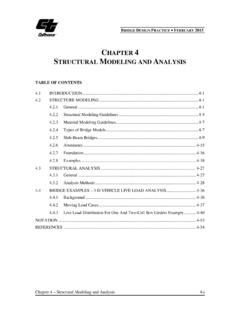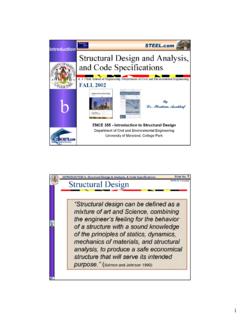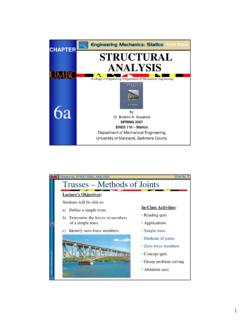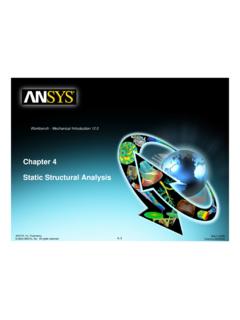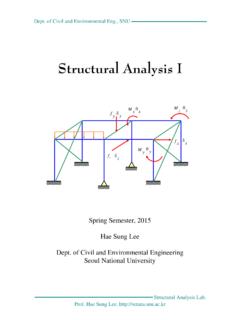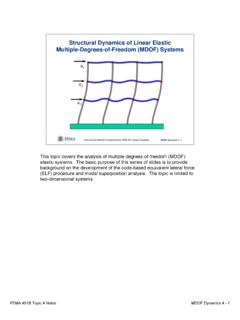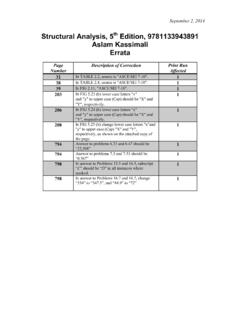Transcription of Structural Analysis - Stanford University
1 Structural AnalysisStructural AnalysisyyForest Flager, MEng, MDesSForest Flager, MEng, MDesSForest Flager, MEng, MDesSCEE214 Reid Senescu and John HaymakerCEE214 October 26, 2009 AdAdAgendaAgenda- Analysis Process- Strengths + Limitations- Future ChallengesReid Senescu and John HaymakerCASE STUDY:Washington MonumentAnalysis ProcessSteps for Structural Analysis : 1) Structural Idealization1) Structural Idealization2)Applying Loads3)Calculating Reactions4)Calculating Internal Forces5)Calculating Internal Stresses6)Evaluating Safety and Efficiency6)Evaluating Safety and EfficiencyReid Senescu and John HaymakerCASE STUDY:Washington MonumentAnalysis ProcessSteps for Structural Analysis : 1) Structural Idealization1) Structural Idealization2)Applying Loads3)Calculating Reactions4)Calculating Internal Forces5)Calculating Internal Stresses6)Evaluating Safety and Efficiency6)Evaluating Safety and EfficiencyReid Senescu and John Haymaker1.
2 Structural Idealization = Structural ModelingAnalysis Process How can I simplify geometry?Assume an average cross-section How is it supported?Assume an average crosssection Fixed baseReid Senescu and John Haymaker1. Structural Idealization = Structural ModelingAnalysis ProcessDeterming an average cross section:Reid Senescu and John Haymaker1. Structural Idealization = Structural ModelingAnalysis ProcessStructural supports (and their idealizations):Reid Senescu and John Haymaker1. Structural Idealization = Structural ModelingAnalysis ProcessFour different types of end conditions:Reid Senescu and John HaymakerWhat do these supports do? CASE STUDY:Washington MonumentAnalysis ProcessSteps for Structural Analysis : 1) Structural Idealization1) Structural Idealization2)Applying Loads3)Calculating Reactions4)Calculating Internal Forces5)Calculating Internal Stresses6)Evaluating Safety and Efficiency6)Evaluating Safety and EfficiencyReid Senescu and John Haymaker2.
3 Applying LoadsAnalysis ProcessWhat loads act on this structure?Reid Senescu and John Haymaker2. Applying LoadsAnalysis ProcessDEAD LOADS:Reid Senescu and John Haymaker2. Applying LoadsAnalysis ProcessWIND LOAD:Reid Senescu and John Haymaker2. Applying LoadsAnalysis ProcessWIND LOAD:Reid Senescu and John HaymakerCASE STUDY:Washington MonumentAnalysis ProcessSteps for Structural Analysis : 1) Structural Idealization1) Structural Idealization2)Applying Loads3)Calculating Reactions4)Calculating Internal Forces5)Calculating Internal Stresses6)Evaluating Safety and Efficiency6)Evaluating Safety and EfficiencyReid Senescu and John Haymaker3. Calculating ReactionsAnalysis ProcessReid Senescu and John Haymaker3. Calculating ReactionsAnalysis ProcessReid Senescu and John Haymaker3.
4 Calculating ReactionsAnalysis ProcessReactions in the Washington Monument (Dead)Reid Senescu and John Haymaker3. Calculating ReactionsAnalysis ProcessReactions in the Washington Monument (Wind)Reid Senescu and John HaymakerCASE STUDY:Washington MonumentAnalysis ProcessSteps for Structural Analysis : 1) Structural Idealization1) Structural Idealization2)Applying Loads3)Calculating Reactions4)Calculating Internal Forces5)Calculating Internal Stresses6)Evaluating Safety and Efficiency6)Evaluating Safety and EfficiencyReid Senescu and John Haymaker4. Calculating Internal ForcesAnalysis ProcessReid Senescu and John Haymaker4. Calculating Internal ForcesAnalysis ProcessReid Senescu and John Haymaker4. Calculating Internal ForcesAnalysis ProcessReid Senescu and John Haymaker4.
5 Calculating Internal ForcesAnalysis ProcessReid Senescu and John Haymaker4. Calculating Internal ForcesAnalysis ProcessReid Senescu and John HaymakerCASE STUDY:Washington MonumentAnalysis ProcessSteps for Structural Analysis : 1) Structural Idealization1) Structural Idealization2)Applying Loads3)Calculating Reactions4)Calculating Internal Forces5)Calculating Internal Stresses6)Evaluating Safety and Efficiency6)Evaluating Safety and EfficiencyReid Senescu and John Haymaker5. Calculating Internal StressesAnalysis ProcessReid Senescu and John Haymaker5. Calculating Internal StressesAnalysis ProcessReid Senescu and John Haymaker5. Calculating Internal StressesAnalysis ProcessReid Senescu and John Haymaker5. Calculating Internal StressesAnalysis ProcessReid Senescu and John Haymaker5.
6 Calculating Internal StressesAnalysis ProcessReid Senescu and John Haymaker5. Calculating Internal StressesAnalysis ProcessReid Senescu and John Haymaker5. Calculating Internal StressesAnalysis ProcessReid Senescu and John HaymakerCASE STUDY:Washington MonumentAnalysis ProcessSteps for Structural Analysis : 1) Structural Idealization1) Structural Idealization2)Applying Loads3)Calculating Reactions4)Calculating Internal Forces5)Calculating Internal Stresses6)Evaluating Safety and Efficiency6)Evaluating Safety and EfficiencyReid Senescu and John Haymaker6. Evaluating Safety and EfficiencyAnalysis ProcessReid Senescu and John Haymaker6. Evaluating Safety and EfficiencyAnalysis ProcessReid Senescu and John HaymakerAliSt th dLiittiAliSt th dLiittiAnalysis Strengths and LimitationsAnalysis Strengths and Limitations- Doha Tower Case StudyReid Senescu and John Haymaker Forest Flager ( Stanford )Grant Soremekun (Phoenix Int)CASE STUDY:Doha TowerStrengths and LimitationsPROJECT OVERVIEW: Gross Area approx.
7 115,000m^2 Chiefly cylindrical tower about 45m in diameter and 182m high at base ofdiameter and 182m high at base of dome 3 basement levels, ground floor and 44 upper levels44 upper levelsReid Senescu and John HaymakerCASE STUDY:Doha TowerStrengths and LimitationsTYPICAL FLOOR PLATE:Reid Senescu and John HaymakerCASE STUDY:Doha TowerStrengths and LimitationsMODELLING VERTICAL Structural SYSTEM:Perimeter Diagrid Circular RC columns Diameters ranging from 800mm to 1700mmInternal Core RC core continuous from foundation to level 44 WllthikiReid Senescu and John Haymaker Wall thicknesses ranging from 250-600mmCASE STUDY:Doha TowerStrengths and LimitationsTYPICAL FLOOR:Core: 2 linked 1D elements with equivalent sections In-situ slab: 1D perimeter elements and bracingDiagrid + Ring: equivalent Nodes: fixed (moment) Reid Senescu and John Haymakerggqsectionsconnections typicalCASE STUDY:Doha TowerStrengths and LimitationsVALIDATION OF CORE MODEL:Tip Stick CoreFull Core Stick CoreReid Senescu and John HaymakerFull CoreStick CoreFull CoreCASE STUDY:Doha TowerStrengths and LimitationsVALIDATION OF WIND LOADING ASSUMPTIONS:Wind DirectionComparison of results: PartyBase Shear -Vb (MN)OT Moment - Mo (MN*m)CSCEC11 (smooth) (hbi h)12 91651 MoReid Senescu and John Haymaker* Coefficients Assessed from Table 7, BS 6399-2(moucharabieh) STUDY:Doha TowerStrengths and LimitationsISSUE: Differential Movement between Core and DiagridSouth diagrid columns take approx.
8 2x the loading of North columnsGLReid Senescu and John HaymakerDeflected Tower Axial LoadsGLCASE STUDY:Doha TowerStrengths and LimitationsISSUE: Diagrid DetailingReid Senescu and John HaymakerFtChllFtChllFuture ChallengesFuture Challenges- Process IntegrationDesign Optimizaton (PIDO)Reid Senescu and John Haymaker Forest Flager ( Stanford )Grant Soremekun (Phoenix Int) Structural Design ProcessStructural Design ProcessFuture ChallengesReid Senescu and John HaymakerCurrent Practice:Current Practice:How are we doing?How are we doing?Future ChallengesSurvey of practitioners at Arup: (Flager, Haymaker 2007)Few design options considered due to significant time spent Reid Senescu and John Haymakermanaging informationFuture ChallengesStructural Shape andStructural Shape andMember SizingMember SizingMember SizingMember SizingReid Senescu and John Haymaker Forest Flager ( Stanford )Grant Soremekun (Phoenix Int)Future ChallengesProblem Description:Problem Description:Main Roof Truss Design Main Roof Truss Design Main Truss 191 members 68 load combinationsOptimization Goals Shape Member SizingANALYSIS LAYERE lement list: not "Cores"Scale: 1 Senescu and John HaymakerPLANSECTIONTRUSS LOCATIONR esults: RationalizedResults.
9 RationalizedMember SizingMember SizingFuture ChallengesBaseline DesignSteel Weight: 1234 tMax Disp: 416 mmOptimized DesignSteel Weight: 808 t(-34%)MDi309 Reid Senescu and John HaymakerMax Disp: 309 mm(-27%)SECTION AREASECTION SIZE BY GROUPR esults: Shape StudiesResults: Shape StudiesFuture ChallengesReid Senescu and John Haymaker










